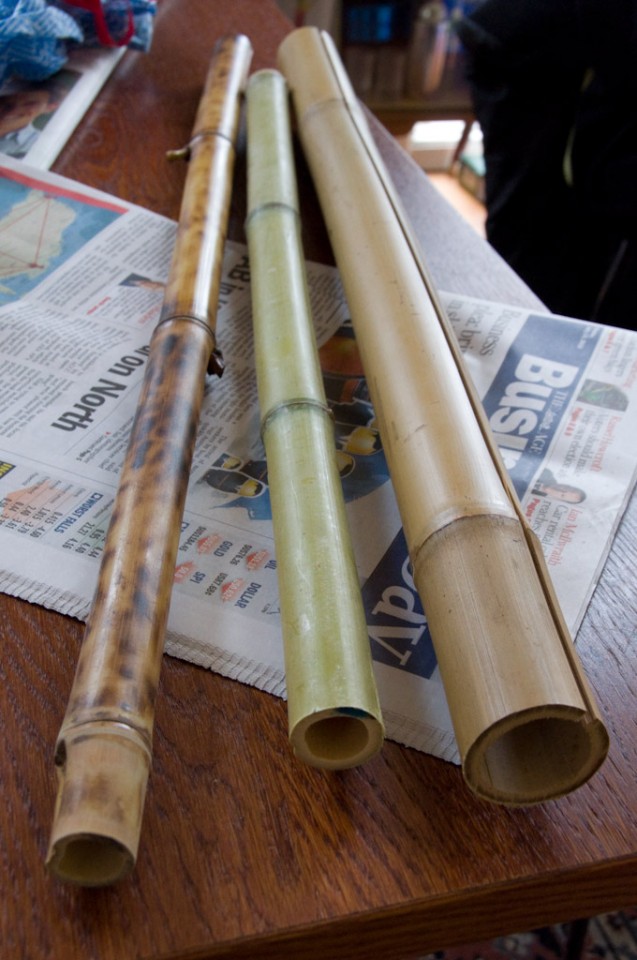Over the course of the last few months I’ve heard a lot about the process for heat treating bamboo. People put it in ovens, attack it with butane torches, smoke it over fires or dry it out in kilns.
Why do they do it? The main reason is to rid the bamboo of any water content so it doesn’t contract or expand with temperatures as easily. A secondary reason is the mottled burnt look kinda looks cool yeah?
Which method is best? I still don’t know. But here’s a few things I’ve picked up that might help.
Exploding bamboo
If you do plan on doing any of these heat treating methods you’ll need to puncture the nodes before heating. Failure to do so will cause a heat buildup in the pocket of air trapped between the nodes and eventually a big kaboom! I used a metal kebab skewer and hit it with the hammer to poke a small hole, but you could use a long drill bit, or a piece of metal rod etc. Try to maintain the integrity of the node as much as possible thou as they add strength to the pole!
Don’t heat treat dried bamboo
If your bamboo is imported from another country (ie. China), like the piece of Tonkin pictured on the right above, it’s probably been dried already. Putting it in a 150degree oven for a few hours will do nothing but make it brittle and crack! It doesn’t necessarily crack whilst in the oven, it’s more likely after you take it out and it cools down. Two pieces I tried cracked in the middle of the night, long after they’d cooled. Woke the house up! I tried leaving it in the oven as it slowly cooled down, but that didn’t help either. More cracking.
Raising the temperature to over 200 degrees just ended up burning the bamboo I tried. I haven’t got a pic of it, but it basically turns to black charcoal that’s very weak and easy to break. Not good.
Heat treat green bamboo
It’s kind of a logical conclusion, but I’ll explain it anyway. Green bamboo (A piece of green Aurea is pictured in the middle above) has lots of water in it, thou the older the culm the less water it has. You can put it in the oven and you’ll get most of the water out. You’ll see it steam out of the ends!
Waving a butane torch over the surface is a better way to go thou, as it not only gets rid of the water, but also the waxy surface of the bamboo gets burned off too. This is important if you’re planning on making epoxy stick to bamboo! The piece of heat treated Aurea (pictured on the left above) used to be the same colour as the middle piece. Cool stuff.
I’ll see if I can record a video of the butane torch heat treating process, as it’s kinda good fun and fascinating to see the colours change. Bamboo’s like a chameleon!
Real science
If you’re after some real hard science about heat treating bamboo, check out this PDF about the subject in the field of making bamboo fishing rods. Long read!

i am starting project of making the bow & arrow out of bamboo, and the problem is plenty bow set but less in time. i will practice this information/advice to start my project.
I heard a lot about heat treating of metal and steel..Thanks for precious knowledge about heat treating of bamboo…
Drying and color browning are done by heat treating. Further more at about 120 to 140 degrees the bamboo starches are changed to a stable material that is less vulnerable to decay and that temperature range results in the optimum strength.
These conclusions are a result of specimens heated at varying temperatures and tested in tension and by exposure to bacteria and mold. Google it look for real papers published by scientists of Universities.
Another method to reduce starches is to soak bamboo in Isopropyl alcohol (also isopropanol, propan-2-ol, 2-propanol, rubbing alcohol or the abbreviation IPA) This cheap liquid might be easier to use than to slow bake bamboo. Baking at higher temperatures to speed up heating the internal structure will damage the outside surface structure. Much like baking a rare roast at 320 to achieve a quick internal 140 temperature damages the surfaces to create a charred flavored. This is not wanted for bamboo.
Finally a third world professor also has discovered that soaking bamboo poles, to treat, can be cheaply done by storing the un-split culm vertically and filling the one top cavity with the liquid. in about 24 hours the liquid has soaked most of the height of the culm or pole.